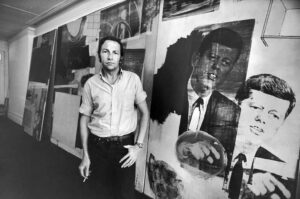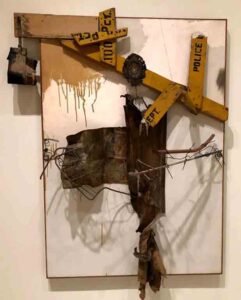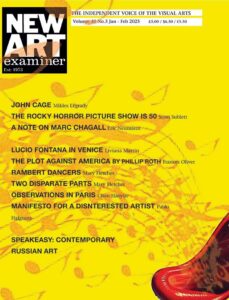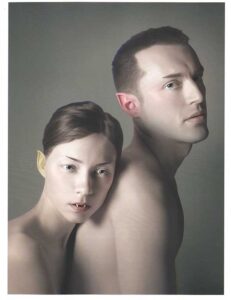
Liviana Martin
The exhibition dedicated to Robert Rauschenberg on the centenary of his birth (Port Arthur 1925 – Captiva Island 2008) is on display in Milan at the Museo del Novecento, recently renovated with an installation that imagines the museum as a space of communication between interior and exterior — a play of connections between the surrounding buildings, including the Duomo, and the works in the permanent collections.
The collections range from the years of Futurism (with masterpieces by Boccioni, Balla, Carrà) to the postwar era, when artists gradually lost faith in modernity and returned to the classical tradition (with De Chirico, Casorati, to name just a few), and extends all the way to contemporary art.

The Rauschenberg exhibition draws connections between the American artist’s works and the main movements of twentieth-century Italian art, from Futurism to Arte Povera — movements that experimented with new languages, techniques, and innovative materials that would forever shape contemporary art.
What unfolds through the various galleries allows us to admire eight works by Rauschenberg created chiefly between the 1970s and 1980s.
In the Futurism Gallery, the passion for automotive speed expressed in the works of Balla and Carrà is set against Rauschenberg’s piece Bumper Slip Late Summer Glut (1987) in which he fused automobile wreckage and parts of gas stations. The series Gluts, produced between 1986 and 1995, represents one of the most innovative paths explored by the artist. His inspiration derived from the economic crisis in America caused by an over-abundance of oil. From this sprang the idea of investigating the theme of abundance in consumer society and, at the same time, of the waste and refuse generated by over-production. In the work on display, our attention is captured by the physicality of the materials, by their instability, and by the play of reflections they produce. Corrugated sheet metal, crumpled metal sheets, and reflective surfaces compose a work that speaks to us of both strength and fragility: strength from the resilience of metal, fragility because the sheets and deformed pieces are destined for decay and abandonment. By elevating the most banal objects to high-impact visual works, the artist intended to give new life to discarded materials that, through the transformative power of art, are reborn as testimonies of an industrial past; “souvenirs without nostalgia,” in Rauschenberg’s own words.
On the upper level, the 1983 work titled Able Was I Ere I Saw Elba, a famous palindrome attributed to Napoleon, refers back to Jacques-Louis David’s painting Bonaparte Crossing the Great Saint Bernard Pass. David’s painting celebrates an epic scene in which Napoleon’s crossing of the Alps takes on heroic and romantic overtones: the commander defies the harsh terrain, becoming a symbol of near-mythical will to power. In Rauschenberg’s work, however, beginning with the title, we witness a reversal and reflection on the transience of power, on the rise and fall of myths. The composition is a triptych depicting the emperor on horseback, surrounded by objects that seem entirely unrelated: a tyre, crumpled sheets of paper, and the famous white horse turned upside down. The use of discarded materials and refuse — typical of Rauschenberg — here seems to evoke the decline and decay of an era and, at the same time, the illusory nature of power.
In the 1950s, Rauschenberg met Alberto Burri and visited the Roman studio where Burri’s works —canvases, rags, and sacks — were on display, profoundly influencing the young Rauschenberg. According to critics, the Combines also derive from Burri’s sack works.

In the piece displayed at the museum, Parsons / Live Plants / Ammonia (Cardboard), from 1971, Rauschenberg transforms cardboard, ordinarily a disposable material, into a sculpture that bears traces of the past. Burri’s works, which serve as a counterpoint (Lo strappo, Combustione, Cretto nero e oro), belong to the Umbrian artist’s autobiography; in Burri’s work, materials are completely divorced from their origins, whereas for the American artist, the discarded objects retain something of a context that recalls their original function.
Further along, Claudio Parmiggiani’s site-specific work Scultura d’ombra (“Shadow Sculpture”) is reflected in one of Rauschenberg’s Phantom pieces, a 1991 series made with photographs and images on anodized mirrored aluminum. Parmiggiani’s work evokes the shadow itself becoming a sculptural object, with presences that dissolve into light: shadows and traces of books rendered in smoke and soot transport the viewer to distant spaces. In the Phantom, a similar dialogue emerges between shadow and reflection, between what is visible and invisible, between material and immaterial. As always, traces of everyday life are preserved in images that continually shift and overlay the viewer’s gaze, who, by moving, enters the work. Phantom represents a meditation on art as interaction with the world and on the capacity of matter to preserve memories even amid constant transformation.
Summer Glut Fence, from 1987, is one of the artist’s most overtly Pop works and marks his last series of metal sculptures. Rauschenberg gathered discarded metal sheets, signs, and structural elements to assemble a sculptural fence. In this instance, the comparison is with Jannis Kounellis — representative of Arte Povera — and Mario Schifano, who belongs to the Italian Pop Art current. Kounellis used materials such as sacks, charcoal, and rope, transforming them into presences; the detritus served as a repository of industrial memories. Schifano, represented here by the large canvas Festa cinese, used logos and brands (Coca-Cola, Esso) as pictorial elements; like Rauschenberg, he depicted consumer goods in three dimensions. With his “fence” of debris—an allegory of a post-industrial landscape — Rauschenberg, alongside Kounellis and Schifano, invites us to reflect on the hidden value of objects and the evocative power of materials.
The Hoarfrost series, created between 1974 and 1976, is one of the artist’s most delicate and poetic experiments, demonstrating how throughout his life he devoted himself to diverse techniques and materials. Through a solvent-transfer process, Rauschenberg transfers images from newspapers, comics, and advertisements onto light fabrics (silk, muslin, satin). The works float lightly in the air; they are not confined within frames or stretchers but are hung directly on the wall with simple nails or tacks, allowing them to move freely like drops of frost. The term “hoarfrost” refers to the meteorological phenomenon of thin ice crystals, just as the thin, transparent fabrics act like veils in which images appear and disappear. While working on this series, Rauschenberg travelled in Israel and India; local crafts inspired him to use fabrics, papers, and other materials in new ways. With this series, the artist moves away from his 1950s/60s works to explore a more evanescent, ephemeral dimension of matter. He transforms industrial printing techniques into visual poetry, creating works that speak of presence and absence, permanence and dissolution — like frost melting in the sun.
In the exhibition, these works are brought into relation with those of conceptual artist Giulio Paolini, who, like Rauschenberg, questions the myth of authorship and the notion of the artist as a solitary genius, showing how an artwork is a continuous dialogue with art history, full of references and quotations.
As the curators observe,
“A central figure in the transition from modern to contemporary art, Rauschenberg always demonstrated insatiable curiosity and a profound commitment to collaboration and the exchange of ideas.”Consequently, “the exhibition pathway reflects the bold experiments of artists who, like Rauschenberg, invented new languages, challenged materials, and revolutionized the conventions of painting and sculpture.”
Rauschenberg and the Twentieth Century
Museo del Novecento, Piazza Duomo, Milan
April 5 – June 29, 2025

